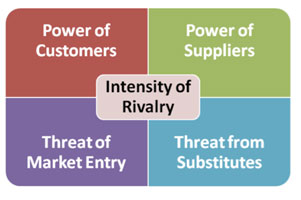In a recent article we looked at Porter’s Five Forces to show how you can analyse your competitive environment.
Of course once you’ve done the analysis you need to come up with a strategy that will help you get an advantage.
Porter identified three generic or basic strategies that a business could choose between.
- Cost leadership
- Differentiation
- Focus
This is about producing your goods and costs at the lowest cost in your industry. Then you sell them at the same price as everyone else and get the benefit of the extra profit. Or you use your cost advantage to sell them at a lower price to everyone else and so get more customers.
Normally this is a good strategy where you’re selling to a broad market.
Sometimes it’s possible to turn a niche market into a mass market by bringing the costs right down.
The classic example of this is Henry Ford. In his day, motor cars were a luxury only bought by the well-off. But by driving production costs down Ford was able to supply a car to the market that normal households could afford. Motor vehicle production became a mass market and Ford has been a wealthy company for decades.
To get cost leadership usually means that you need to be able to find a way to produce your goods or services in a more efficient way than anyone else, be able to get access to a unique source of lower cost supplies, or be able to completely avoid some costs.
It’s not impossible for smaller businesses to be cost leaders. In some cases their agility and willingness to make more sacrifices can be an advantage.
Generally speaking, though, cost leadership is a difficult strategy for a small business to pursue effectively in the long term.
- Differentiation
Differentiation is about offering your customers something different, extra or special that they value. Your customers then see your product or service as better or different to your competitors and are willing to pay extra for it.
For this to work for you, then the cost of providing the extra value must be less than the price premium you’ll get. For instance, a free iPhone with every order of paper may be attractive to a paper buyer. But it’s highly unlikely they’ll be willing to pay enough of a premium for you to still make a profit.
A differentiation strategy often provides some protection from increases in prices from your suppliers. Your customer will find it more difficult to find a substitute and so will accept you passing on supplier price increases.
To make a success of differentiation, you need to have an innovative approach and be able to see what makes you – or could make you – different. You’ll also need to concentrate on sales and marketing so that you successfully communicate the extra value to your potential customers.
These are skills that many small business owners have or can develop. So differentiation is often a good strategy for them.
- Focus
Focus is about concentrating on a niche market. And using either cost leadership or differentiation within that niche market.
By tailoring your products or services you’ll be in a better position to meet the unique needs of the niche market. They’ll be more likely to buy from you than buy a general market product or service that they then have to adapt. It also leads to a high degree of loyalty towards you.
To be able to use the focus strategy you need to know a particular market segment very well.
Focusing on a niche may mean a lower volume of sales, but those sales can often be more profitable because of the leeway the customer loyalty will give you in pricing.
Can strategies be combined?
In his work Porter argued that a business should only pursue one strategy, otherwise over the long-term there won’t be any competitive advantage won.
On the other hand, some feel that pursuing a single strategy doesn’t always work because customers aren’t one-dimensional. They’ll often look for a combination of factors – say a certain level of quality, design and price – to be present when they buy something.
It’s not an easy call to make, but certainly if you’re pursuing one strategy you need to make sure you don’t bring in elements of another strategy that will undermine you.
For example, suppose a business is following a differentiation strategy of making very high quality products. What will happen if it also tries to be a cost leader? At worst it will undermine its quality and at best its customer will be confused.
Which one should I pursue?
There is no one-size-fits-all answer to this question. It will depend on how you currently fit into the marketplace.
For example, if you find that you’re often being outbid or are losing sales to competitors based on price, consider why that’s happening.
Ask yourself questions like:
- Am I able to reduce my costs so that I can match my competitors’ prices?
- Will I be making enough profit if I do that?
- Do I have the funds to sustain that approach?
- Is there something I could add to differentiate my product or service that would make it more appealing?
- Is there a niche among my potential customers that aren’t being well-served by the market?
These questions and ones like them will help you to explore the possibilities and quite likely you will start to get a clearer idea of which strategy would be a good one for you.
There is, however, one strategy often employed by new businesses that’s a bad one. Look out for a future article on that subject.
